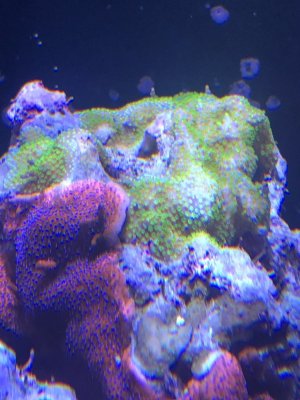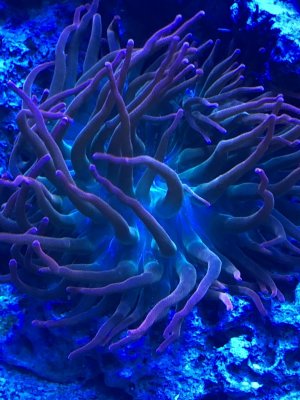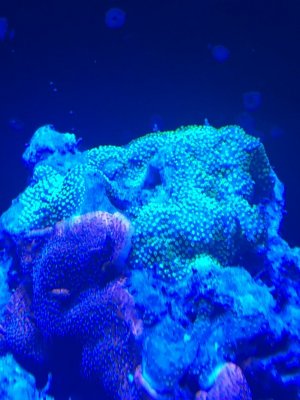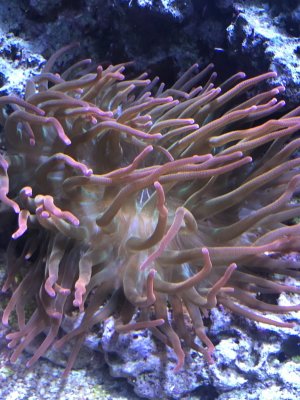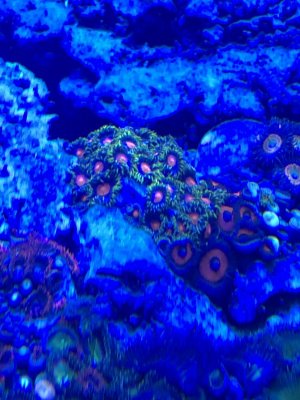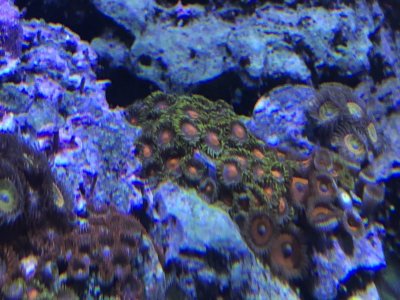I am not sure if you sen this chart before you bought the Ushio 20 K? But there is not much value to that type of lamp
Navigation
Install the app
How to install the app on iOS
Follow along with the video below to see how to install our site as a web app on your home screen.
Note: This feature may not be available in some browsers.
More options
You are using an out of date browser. It may not display this or other websites correctly.
You should upgrade or use an alternative browser.
You should upgrade or use an alternative browser.
Phoenix 14K 250W DE vs 20K 250DE
- Thread starter cwk84
- Start date
- Tagged users None
The red zoas you can see in my picture looked just like that under my T5s before the tank crash which obviously took the better of them. Yes, this is what I want and I was under the impression that this is what I will be getting with MHs since, you know, they color up corals better than LEDs. Sorry for the sarcasm. I had to haha. I want healthy colorful corals and if MH won't get me there I will do the switch back to T5s or even LEDs. Regardless, I will stick to what I said. I will let the tank adjust and let the Ushios do its thing. I really like the color temperature of the tank now. I have drab looking corals so it would be hasty blame the lack of coloration on the fact that MHs won't make corals fluoresce like LEDs.
This has become so convoluted I don’t think anyone is grasping the spirit of the MH argument, as indicated by the responses that keep coming in. Use what you like and what you want. Don’t worry about what someone else thinks you should use. Look at peoples tanks. Find ones YOU LIKE. and do what they do. If you have yet to see a tank with actinic pop under pure metal halides, then they’re not for you. If you have seen it, emulate that lighting, and if it still doesn’t look the same, then the lights are not the culprit. There’s more to color than lights. I can shift my coral colors dramatically by manipulating water quality and flow
This has become so convoluted I don’t think anyone is grasping the spirit of the MH argument, as indicated by the responses that keep coming in. Use what you like and what you want. Don’t worry about what someone else thinks you should use. Look at peoples tanks. Find ones YOU LIKE. and do what they do. If you have yet to see a tank with actinic pop under pure metal halides, then they’re not for you. If you have seen it, emulate that lighting, and if it still doesn’t look the same, then the lights are not the culprit. There’s more to color than lights. I can shift my coral colors dramatically by manipulating water quality and flow
Agreed.
Halides are not going to have the pop leds have.. You can add led or actinic to help with the pop but it will never have the pop a royal blue led has.
Halides will bring out the true colors of coral.. Meaning you do not need a bunch of blue to see the coral colors. But a coral like Walt Disney is a washed out coral period unless under royal blue led.. It was a great way to sell a pretty ugly coral but putting it under halides isn't going to color it up, It is a plain coral that has allot of fluorescence not allot of true color.
Allot of the old school corals will look better under a halide. Allot of the newer corals are picked because they look good under led and have a lot of fluorescence.
You can take a coral that has true color and put it under led and it could loose it true colors but still may have it fluorescence. No one really knows what will happen to a coral under a certain light. There are always the exception too..
Yes there are too many
Blanket statements and unrealistic expectations going on. It’s a new school mindset, being alerted to an old school methodology. They just aren’t compatible. Square peg/round hole kind of thing
Blanket statements and unrealistic expectations going on. It’s a new school mindset, being alerted to an old school methodology. They just aren’t compatible. Square peg/round hole kind of thing
Halides will bring out the true colors of coral.. Meaning you do not need a bunch of blue to see the coral colors.
Nonsense! This is what I'm talking about! There is no such thing as "true" color. Every coral will display a different color depending on the spectrum it is subjected to. If you determine MH colors to be "true" you are implying that LED or T5 colors are "false" which is a flawed argument. Blue light will not bring out the color of corals if the coral doesn't have pigments to begin with or the pigments that respond to blue lighting such as green. Green will always pop under any blue light because the pigment responds best to the blue end of the spectrum. But reds, pinks, etc. won't. A pink birdsnest under royal blue LEDs looks like sh...! You will need to introduce reds and greens to bring out these pigments. It doesn't matter whether those greens and reds are delivered by MHs, LEDs or T5s. However, the controllability of LEDs gives you the option to individualize the spectrum to bring out the pigments of all of your corals. If you want to bring out more greens, you'd have to go for a 20k bulb. If you'd like to bring out some reds and pinks you might love a 14k bulb. But what if you have all of these colors? Then there will be a trade-off. Some coral will look stunning some won't. With LEDs this not an issue anymore because you can control the spectrum. And this is also where all the issues arise when people run weird spectrums that hurt the corals. If you get a frag from such a person, yes, it will look super discolored under your MHs. But that doesn't mean that LEDs won't color up corals as "nicely" as MHs. I could argue that Radeon fixtures bring out the "true" color of corals based on my subjective impression of colorful Radeon SPS tanks. And if you told me that this is just because of the royal blues I'd go on to claim that you are not used to see the "true" colors of these corals because your metal halides won't show every pigment in every coral due to the fixed spectrum. How would you be able to prove me wrong? You couldn't because, at the end of the day, it's a visual and very subjective hobby.
The only sensible person is Bbp because he basically says it is subjective. Go for what you want to see. Emulate what others do and don't listen to other peoples subjective descriptions of "pop" or "colorful" or "true colors". What a piece of SOUND advice. I'm unsubbing from this thread.
Yes there are too many
Blanket statements and unrealistic expectations going on. It’s a new school mindset, being alerted to an old school methodology. They just aren’t compatible. Square peg/round hole kind of thing
Yea for me I just do not like all the blue Windex color of allot of the led tanks. I think it just looks bad and makes everything else washed out including the fish colors but boy some of the corals glow. All the blue hurts my eyes.. It preference really. I like led to supplement my lighting though..
Everyone always say when you dive you loose all the color. Every time I have dove I do not see corals glowing in 60 to 100 feet of water... To me it is not natural.. Anyway when you get deeper what do they use to make the coral look better for pictures or filming and show the colors of coral?? Not a blue light....
Nonsense! This is what I'm talking about! There is no such thing as "true" color. Every coral will display a different color depending on the spectrum it is subjected to. If you determine MH colors to be "true" you are implying that LED or T5 colors are "false" which is a flawed argument. Blue light will not bring out the color of corals if the coral doesn't have pigments to begin with or the pigments that respond to blue lighting such as green. Green will always pop under any blue light because the pigment responds best to the blue end of the spectrum. But reds, pinks, etc. won't. A pink birdsnest under royal blue LEDs looks like sh...! You will need to introduce reds and greens to bring out these pigments. It doesn't matter whether those greens and reds are delivered by MHs, LEDs or T5s. However, the controllability of LEDs gives you the option to individualize the spectrum to bring out the pigments of all of your corals. If you want to bring out more greens, you'd have to go for a 20k bulb. If you'd like to bring out some reds and pinks you might love a 14k bulb. But what if you have all of these colors? Then there will be a trade-off. Some coral will look stunning some won't. With LEDs this not an issue anymore because you can control the spectrum. And this is also where all the issues arise when people run weird spectrums that hurt the corals. If you get a frag from such a person, yes, it will look super discolored under your MHs. But that doesn't mean that LEDs won't color up corals as "nicely" as MHs. I could argue that Radeon fixtures bring out the "true" color of corals based on my subjective impression of colorful Radeon SPS tanks. And if you told me that this is just because of the royal blues I'd go on to claim that you are not used to see the "true" colors of these corals because your metal halides won't show every pigment in every coral due to the fixed spectrum. How would you be able to prove me wrong? You couldn't because, at the end of the day, it's a visual and very subjective hobby.
The only sensible person is Bbp because he basically says it is subjective. Go for what you want to see. Emulate what others do and don't listen to other peoples subjective descriptions of "pop" or "colorful" or "true colors". What a piece of SOUND advice. I'm unsubbing from this thread.
You are reading to much into my post, nit picking , trying to start an argument or really defensive. Most reference for lighting is under sun light. I can take the color of the light and change it making a object appear black or purple or another color by changing the color of the light and not the color of the object..
I am saying if a coral is blue it will show up blue. More or less color rendering under white light. I am not saying what color it will turn.. I have seen a chalice glow bright orange under mostly blue led but under white light it is brown, the actual color of the coral. But corals shown under halides are picked for their color not necessarily their fluorescence.. Corals picked for people who run heavy blue leds are usually picked more for their florescence not their perceived colors. This is because the colors do not show up unless you run more whiter light which some do but allot of people run lots of blue.. Of coarse corals will change color depending on spectrum, intensity and UV..
To me the UV is what led lacks.
for me I like a more natural light than the Windex color and i like to use some Royal blue led for some pop. A little balance.
Right now I use mainly t-5 with led and no halides.
Last edited:
Something that is not being mentioned.
Regarding true color/false color. Consider this....
A coral contains many chromoproteins (or what I think people are dubbing the term “real color), and fluorescent proteins (or false color as it were). They’re all there.
We all have read the articles. Certain fluorescent proteins are excited and give off one color light when exposed to another. Typically in the UV to light blue range. Part of the reason the blue+ bulb looks so ugly, but provides such great fluorescence of just about every color. It’s for almost the entire violet and blue spectrum represented, while appearing that odd sky/blue green color.
Enter daylight bulbs, you start getting green, yellow, orange, and red wavelengths which will be reflected by the chromoproteins. Thus making the coral appear whatever color it appears.
The more monochromatic the light is toward the blue end, the more fluorescence you tend to get. And get more wavelengths in there, to a warmer kelvin, and other colors begin expressing as well. It’s not like the fluorescence is gone. It’s just not bright enough to stand out.
And we all know what happens when you mix every color together. Brown. That’s why most corals under 6500k and outdoors appear brown. It’s true full spectrum lighting. Every wavelength, exciting every color at once makes for a brown coral.
Yes you get the occasional specimens with an absolute ton of one color or another in their tissue that can dominate, such as purple monster, or your red planet tables and things like that. But generally speaking, the more green yellow and red present, the more muted the fluorescence will be. It’s like mixing paints.
I don’t call them real or fake color, it’s just about using your lighting correctly to both develop, and express what you want to see. And being patient in the process. You can’t just shuffle back and forth between lighting tech, led settings, or bulbs and expect to have any indication whatsoever of what the corals will appear like. It’s going to take weeks to months to grow the pigments in their tissue that they’re being influenced to grow based on their available light.
And I agree. Walt Disney is drab under true white light. But looks it’s best under the ati blue+ bulb (better than it does under royal blue only. My WD looks orange and purple under blue leds. Not enough different wavelengths to fluoresce the other colors it can have. Blue+
Bulbs tend to also bring out the pink and green it can get as well for a true 4 color gradient.
This is mine under 14k mh

No...it doesn’t look like you’re on drugs like a lot of corals do. That where I differ strongly with the OP. I don’t think a tank under 10-14k lighting is ugly. I find excessive fluorescence to look odd and tiresome. Like the glofish tanks at pet smart, or like playing laser tag/mini golf. The black light effect wears on me and I could do without it honestly. I genuinely think a natural looking tank is more pleasing to view. 10-14k is bright, vibrant, and just blue enough to get subtle differences in color among the sps. The big massive RC TOTM winners in the 2000-2010 era are the absolute pinnacle of goals for me in what I want my tank to look like. Not much fluorescence going on.
Regarding true color/false color. Consider this....
A coral contains many chromoproteins (or what I think people are dubbing the term “real color), and fluorescent proteins (or false color as it were). They’re all there.
We all have read the articles. Certain fluorescent proteins are excited and give off one color light when exposed to another. Typically in the UV to light blue range. Part of the reason the blue+ bulb looks so ugly, but provides such great fluorescence of just about every color. It’s for almost the entire violet and blue spectrum represented, while appearing that odd sky/blue green color.
Enter daylight bulbs, you start getting green, yellow, orange, and red wavelengths which will be reflected by the chromoproteins. Thus making the coral appear whatever color it appears.
The more monochromatic the light is toward the blue end, the more fluorescence you tend to get. And get more wavelengths in there, to a warmer kelvin, and other colors begin expressing as well. It’s not like the fluorescence is gone. It’s just not bright enough to stand out.
And we all know what happens when you mix every color together. Brown. That’s why most corals under 6500k and outdoors appear brown. It’s true full spectrum lighting. Every wavelength, exciting every color at once makes for a brown coral.
Yes you get the occasional specimens with an absolute ton of one color or another in their tissue that can dominate, such as purple monster, or your red planet tables and things like that. But generally speaking, the more green yellow and red present, the more muted the fluorescence will be. It’s like mixing paints.
I don’t call them real or fake color, it’s just about using your lighting correctly to both develop, and express what you want to see. And being patient in the process. You can’t just shuffle back and forth between lighting tech, led settings, or bulbs and expect to have any indication whatsoever of what the corals will appear like. It’s going to take weeks to months to grow the pigments in their tissue that they’re being influenced to grow based on their available light.
And I agree. Walt Disney is drab under true white light. But looks it’s best under the ati blue+ bulb (better than it does under royal blue only. My WD looks orange and purple under blue leds. Not enough different wavelengths to fluoresce the other colors it can have. Blue+
Bulbs tend to also bring out the pink and green it can get as well for a true 4 color gradient.
This is mine under 14k mh

No...it doesn’t look like you’re on drugs like a lot of corals do. That where I differ strongly with the OP. I don’t think a tank under 10-14k lighting is ugly. I find excessive fluorescence to look odd and tiresome. Like the glofish tanks at pet smart, or like playing laser tag/mini golf. The black light effect wears on me and I could do without it honestly. I genuinely think a natural looking tank is more pleasing to view. 10-14k is bright, vibrant, and just blue enough to get subtle differences in color among the sps. The big massive RC TOTM winners in the 2000-2010 era are the absolute pinnacle of goals for me in what I want my tank to look like. Not much fluorescence going on.
To me coral would do best under the light they spent years adapting too in the ocean.. A coral grown in shallow water under more daylight would do best under more daylight. A coral from deeper where the spectrum more blue and would do better under more blue.. There is a reason most corals only grow between certain depths in the ocean. Most corals grow between a certain depth range, there are exceptions.
Some corals can adapt, some can not.
Most SPS come from shallower water and are exposed to wider spectrum would it not be right to assume they would do better under that spectrum? Some corals sit out of the water in direct full spectrum sunlight and UV.
Some corals can adapt, some can not.
Most SPS come from shallower water and are exposed to wider spectrum would it not be right to assume they would do better under that spectrum? Some corals sit out of the water in direct full spectrum sunlight and UV.
I don’t call them real or fake color, it’s just about using your lighting correctly to both develop, and express what you want to see. And being patient in the process. You can’t just shuffle back and forth between lighting tech, led settings, or bulbs and expect to have any indication whatsoever of what the corals will appear like. It’s going to take weeks to months to grow the pigments in their tissue that they’re being influenced to grow based on their available light.
That is exactly what I meant. Every lighting source will display a coral differently given enough time to adapt (and given the spectrum is sufficient as was mentioned above) and it is up to YOU what YOU want to see in YOUR tank. So when someone tells me MHs display the true colors of corals a get a little confused because to me color is subjective. You might say that xyz coral looks perfect in your tank but I might say it looks boring because I saw it in someone else tank where the chemistry and lighting source is totally different. Like someone here mentioned, at the end of the day, it is a visual hobby.
- Joined
- Feb 15, 2012
- Messages
- 4,735
- Reaction score
- 3,412
It is a "visual hobby", so go get any light that pleases your eyes.
That is what we have been telling you all along.
We don't understand why you keep coming back to hear the same over and over again.
Most of your arguments and questions, including the ones from PMs between you and me, were answered before in this thread. If you like the LED effect go get some LEDs, don't keep your halides then. Fine with us.
Do you think we are here to preach halide to you in order to keep them over your tank? Of course not!
We tried to tell you some facts about your situation to try to help you and you come against us?
Everyone does what they want and we respect.
The misinterpretation from your part is way too much in this thread.
That is what we have been telling you all along.
We don't understand why you keep coming back to hear the same over and over again.
Most of your arguments and questions, including the ones from PMs between you and me, were answered before in this thread. If you like the LED effect go get some LEDs, don't keep your halides then. Fine with us.
Do you think we are here to preach halide to you in order to keep them over your tank? Of course not!
We tried to tell you some facts about your situation to try to help you and you come against us?
Everyone does what they want and we respect.
The misinterpretation from your part is way too much in this thread.
Last edited:
No...it doesn’t look like you’re on drugs like a lot of corals do. That where I differ strongly with the OP. I don’t think a tank under 10-14k lighting is ugly. I find excessive fluorescence to look odd and tiresome. Like the glofish tanks at pet smart, or like playing laser tag/mini golf. The black light effect wears on me and I could do without it honestly. I genuinely think a natural looking tank is more pleasing to view. 10-14k is bright, vibrant, and just blue enough to get subtle differences in color among the sps. The big massive RC TOTM winners in the 2000-2010 era are the absolute pinnacle of goals for me in what I want my tank to look like. Not much fluorescence going on.
I agree with most of this post but this part is me right here.
This is why when I ran Iwasakis I added actinic or my when I switched to Ushios.. I like a whiter light and add the actinics for a little pop and a little more blue. Some where around 10,000 kelvin to 14,000k is what I like.
I just do not like the day glow colors. It is not natural and when I dive I do not see that..
With T5 I go for the 10-12k look and add two actinic lamps for a little pop (fluorescence).
And when I speak true color I mean a coral that looks good under white light and you see the actual color of the coral.
When you look at the first picture in the link below of the coral out of water. The ones that show the color in sunlight are what I like.. Those brown ones may be awesome under royal blue leds or blue + who knows but they do not under white or full spectrum light they are brown. That is what I am talking about when I say true colors.
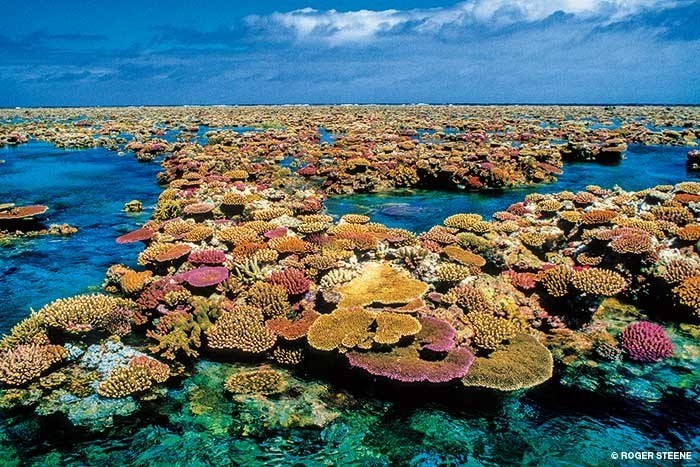
A Response to ABC’s Media Watch’s “Shoot the Coral Messenger” Flimflam!
Guest essay by Jim Steele Director emeritus Sierra Nevada Field Campus, San Francisco State University and author of Landscapes & Cycles: An Environmentalist’s Journey to Climate Skepticism Gre…
 wattsupwiththat.com
wattsupwiththat.com
Last edited:
The best MH lighting was 10K metal halide lamps with multiple T12 VHO True Actinic lamps. This covered all ends of the spectrum. Purple Tang tails looked almost orange they where so bright yellow. The problem is no more T12 VHO Lamps!
The best MH lighting was 10K metal halide lamps with multiple T12 VHO True Actinic lamps. This covered all ends of the spectrum. Purple Tang tails looked almost orange they where so bright yellow. The problem is no more T12 VHO Lamps!
I agree the original UVL VHO lamps:
Actually you still can get the original VHO t-12 lamps:
T5 & VHO Aquarium Lighting | Premium Aquatics
Looking for T5 HO (High Output) or VHO (Very High Output) lighting? We carry an incredible selection of high quality, high performance options to accentuate coral and fish colors and aid in coral growth.
I didn't think they did sell them either till Sally Joe from Garfs mentioned it to me..
I kick myself because when I moved I left behind a 4' Hamilton MH fixture because it had VHO.. I could have used it now.
By the way they still sell t-12 vho lamps so anyone who thinks halides wont be around in several years.. Halides were far more popular than t-12 vhos ever were and these have not been used in how long now?
Last edited:
- Joined
- Sep 18, 2017
- Messages
- 5,637
- Reaction score
- 3,470
I agree with most of this post but this part is me right here.
This is why when I ran Iwasakis I added actinic or my when I switched to Ushios.. I like a whiter light and add the actinics for a little pop and a little more blue. Some where around 10,000 kelvin to 14,000k is what I like.
I just do not like the day glow colors. It is not natural and when I dive I do not see that..
With T5 I go for the 10-12k look and add two actinic lamps for a little pop (fluorescence).
And when I speak true color I mean a coral that looks good under white light and you see the actual color of the coral.
When you look at the first picture in the link below of the coral out of water. The ones that show the color in sunlight are what I like.. Those brown ones may be awesome under royal blue leds or blue + who knows but they do not under white or full spectrum light they are brown. That is what I am talking about when I say true colors.

A Response to ABC’s Media Watch’s “Shoot the Coral Messenger” Flimflam!
Guest essay by Jim Steele Director emeritus Sierra Nevada Field Campus, San Francisco State University and author of Landscapes & Cycles: An Environmentalist’s Journey to Climate Skepticism Gre…wattsupwiththat.com
Ok first I agree w/ you but in doing research there are only about a dozen "reflective" pigments w/ orders
of magnatude more of flour. pigments.
Note in the GBR pic all you really have is brown, yellow, and purple..AFAICT.
There is def a "philosophy" between flor vs natural (and the continuum in between)
Ok first I agree w/ you but in doing research there are only about a dozen "reflective" pigments w/ orders
of magnatude more of flour. pigments.
Note in the GBR pic all you really have is brown, yellow, and purple..AFAICT.
There is def a "philosophy" between flor vs natural (and the continuum in between)
Maybe it is also one picture.
But there brown corals everywhere on the reef. Collectors are taking the most colorful corals for the hobby though. Look at allot of the A humilis corals and how many colors they come in and are a very shallow water acro. It is one of my favorites but requires massive flow in different directions.
- Joined
- Sep 18, 2017
- Messages
- 5,637
- Reaction score
- 3,470
Yea I know.. just shows how complicate it all really is.. and a minor point what "color" is the "real" color of various species..Maybe it is also one picture.
But there brown corals everywhere on the reef. Collectors are taking the most colorful corals for the hobby though. Look at allot of the A humilis corals and how many colors they come in and are a very shallow water acro. It is one of my favorites but requires massive flow in different directions.

Feature Article: Coral Coloration - Part 7: Coral Reflectance, Chromoproteins and Environmental Factors Affecting Non-fluorescent Pigmentation — Advanced Aquarist | Aquarist Magazine and Blog
All the information presented in the previous six installments of this series has been only a precursor to this article, where we identified coral pigments as described in scientific literature.
It's really fascinating..
We must be careful to avoid the pitfall of thinking a single environmental parameter alone is responsible for coloration – many factors are synergistically linked. Although light certainly seems important, photosynthesis depends upon a source of inorganic carbon (such as bicarbonates – ‘alkalinity’ – or CO2) which in turn could be potentially limited by insufficient water flow. By the same token, CO2, due to coral and zooxanthellae respiration, could possibly accumulate within the stagnant boundary layer surrounding the coral and thus drive pH downwards. Temperature is probably less important to the coral animal than its resident zooxanthellae. However, loss of zooxanthellae could be catastrophic to the coral so, naturally, avoid temperatures approaching 80ºF or so. Carefully monitor any corals directly under metal halide lamps for loss of pigmentation due to ‘spot warming’ resulting in bleaching.
The only chromoprotein identified in an aquarium coral, so far, is Pigment 580. Currently, it is known to occur in only Acropora specimens. This chromoprotein seems to be expressed at relatively high light levels (~400 µmol·m²·sec) when other factors (such as those mentioned above) are correct.
Though only briefly discussed, hobbyists should abandon the thought that ultraviolet radiation is responsible and therefore necessary for inducing the expression of chromoproteins. It is apparent that violet and blue wavelengths can also cause coloration shifts. Excessive ultraviolet radiation usually isn’t a problem with fluorescent lamps and it is definitely not a problem with the newer LED luminaires. However, hobbyists should shield their metal halide lamps for UV radiation by using acrylic panes. For those doubters, I’ll present some information on the effects of UV on some fluorescent proteins in the next installment of this series.
Much like the rest of life, you cannot excel at everything, but if you do, then you come out OK.
In life, it might be best to be 100% at being a spouse/parent, hygiene or making money, then it is OK to only be 50% on yard work, keeping your car clean or making your bed. There are things that are more important than others. Reefing is no different. I will take the best possible lighting and middling/competent level of parameters and stability over the perfect stability and parameters and a middling level of lighting. Some are just more important than others. Just like never mowing your yard, I am not saying that you can let parameters or stability go all to hell.
The GBR had acropora in the purple, pink, blue, white, brown, yellow, green and pretty much all colors of corals under 6500k ish( just under the water) lighting. There were more colors with NPS and softies. There was no LED pop, of course, where the corals look like Pandora from Avatar, but the colors are really nice nonetheless. The pinks, purples and yellows probably looked better in the ocean whereas some others would look better with bluer light.
I consider "real" color to be a color that can be rendered and illuminated with nearly any different light source that can be replicated by nearly anybody in the hobby. Blue tort is going to be blue under daylight or all-blue LED and nearly anybody can do this. When you need just one type of light, or if only one person can get the color, then I consider that a trick.
In life, it might be best to be 100% at being a spouse/parent, hygiene or making money, then it is OK to only be 50% on yard work, keeping your car clean or making your bed. There are things that are more important than others. Reefing is no different. I will take the best possible lighting and middling/competent level of parameters and stability over the perfect stability and parameters and a middling level of lighting. Some are just more important than others. Just like never mowing your yard, I am not saying that you can let parameters or stability go all to hell.
The GBR had acropora in the purple, pink, blue, white, brown, yellow, green and pretty much all colors of corals under 6500k ish( just under the water) lighting. There were more colors with NPS and softies. There was no LED pop, of course, where the corals look like Pandora from Avatar, but the colors are really nice nonetheless. The pinks, purples and yellows probably looked better in the ocean whereas some others would look better with bluer light.
I consider "real" color to be a color that can be rendered and illuminated with nearly any different light source that can be replicated by nearly anybody in the hobby. Blue tort is going to be blue under daylight or all-blue LED and nearly anybody can do this. When you need just one type of light, or if only one person can get the color, then I consider that a trick.
Similar threads
- Replies
- 41
- Views
- 1,011
- Price: $600 - $150 - $250 - $80
- Shipping Available
- Replies
- 1
- Views
- 251
- Price: $175
- Shipping Available
- Replies
- 3
- Views
- 382
- Replies
- 23
- Views
- 1,014









